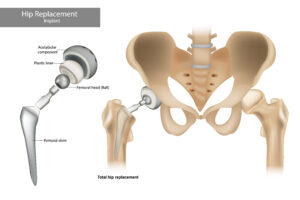
Table of Contents
- What Happens Right After Surgery?
- Hip Replacement Recovery Timeline
- Tips to Make Recovery Smoother
- When to Call Your Surgeon
- Meet Dr. Eric Buxbaum
What Happens Right After Surgery?
The idea of hip surgery can be intimidating—but the reality is far more encouraging. At AOSMI, most patients are up and moving the same day. Whether you’re going home or staying one night, the early hours after surgery are focused on stability, safety, and comfort.
You’ll be guided through standing and walking with a walker or cane, and monitored by your care team to make sure you’re on the right track from the very beginning.

Hip Replacement Recovery Timeline
Week 1–2: Building a Foundation
Walk for 5–10 minutes every hour. This is generally enough exercise in the early stages, and physical therapy is typically recommended if progress is not as expected.
Week 3–6: Returning to Daily Life
Expect improved strength and reduced stiffness. Many patients return to driving, work (if not physically demanding), and light errands.
Week 6–12: Low-Impact Activity Resumes
You may return to hobbies like biking, swimming, weightlifting or golfing. Strength training continues to help restore mobility and balance.
Month 3 and Beyond: Full Recovery
Full joint function continues to improve through the year. Most patients report better sleep, pain relief, and increased independence.
Tips to Make Recovery Smoother
- Follow your PT plan. Movement builds strength and prevents stiffness.
- Don’t skip rest. Healing requires downtime, too.
- Use your walker early. It protects your new joint and reduces fall risk.

Physical therapist guiding hip replacement patient through recovery exercises. - Set realistic goals. Each small win is progress.
- Keep a recovery journal. Tracking daily improvements helps with motivation.
When to Call Your Surgeon
Although complications are rare, call your provider if you notice:
- Increasing pain or swelling after the first week
- Fever or chills
- Fluid or redness at the incision site
- Difficulty bearing weight
Meet Dr. Eric Buxbaum
Dr. Eric Buxbaum is a board-certified orthopedic surgeon at AOSMI, fellowship-trained in hip and knee replacement. With extensive experience in minimally invasive techniques and patient-centered care, Dr. Buxbaum’s goal is to help patients reclaim their mobility and confidence through expert orthopedic treatment.
“It’s not just about replacing a joint—it’s about restoring independence.”
Schedule a Consultation
Take the first step toward a stronger, more active you. Book an appointment with Dr. Buxbaum today. Call 732-720-2555 or request an appointment below.








